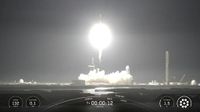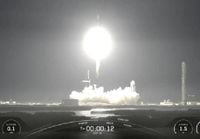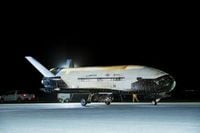On the night of August 21, 2025, a familiar yet mysterious sight streaked across the skies above Cape Canaveral, Florida. Another U.S. military mini shuttle – the Boeing-made X-37B – blasted off aboard a SpaceX Falcon 9 rocket, embarking on its eighth mission to conduct classified experiments in orbit. With no crew aboard, the reusable space plane once again set out to push the boundaries of military and scientific innovation far above Earth’s surface, according to the Associated Press and other major outlets.
This latest launch underscores the United States’ ongoing commitment to developing next-generation space technologies, especially those with military and national-security implications. As noted by Newsweek, the X-37B’s new mission will test high-bandwidth inter-satellite laser communications and cutting-edge navigation systems that operate independently of GPS. The U.S. Space Force, which oversees the project, has highlighted the significance of these experiments in building a more resilient and diversified space infrastructure.
General Chance Saltzman, the chief of space operations for the U.S. Space Force, emphasized the mission’s broader importance. “This mission is about more than innovation. It’s about making our Joint Force more connected, more resilient, and ready to operate in the face of any challenge. That’s how America’s Space Force secures our Nation’s interests in, from, and to space,” Saltzman stated in July, as reported by Newsweek.
The X-37B, which first took flight in 2010, has become something of a workhorse for the Pentagon’s secretive space ambitions. Measuring 29 feet (9 meters) in length with a wingspan of nearly 15 feet (4.5 meters), the vehicle resembles a miniature version of NASA’s retired space shuttle. But unlike its larger predecessor, the X-37B is fully autonomous, capable of reentering Earth’s atmosphere and landing itself without human intervention, according to Boeing.
Since its debut, the X-37B program has accumulated a remarkable 4,208 days in orbit, spanning multiple missions of varying lengths. The last mission, which launched in December 2023 and returned to Earth in March 2025, lasted a whopping 434 days – just over a year. That flight, notably, marked the first time the X-37B was sent aloft aboard a SpaceX Falcon Heavy rocket to a highly elliptical orbit, where it tested a maneuver known as aerobraking. This technique, which uses atmospheric drag over multiple passes to alter an orbit while conserving fuel, showcased the platform’s flexibility and the U.S. military’s growing interest in advanced orbital operations.
General Saltzman reflected on the previous flight’s achievements, saying, “Mission 7 broke new ground by showcasing the X-37B’s ability to flexibly accomplish its test and experimentation objectives across orbital regimes. The successful execution of the aerobraking maneuver underscores the U.S. Space Force’s commitment to pushing the bounds of novel space operations in a safe and responsible manner.”
While the specifics of each X-37B mission remain classified, the U.S. Space Force has provided glimpses into the types of experiments conducted aboard the space plane. Previous flights have tested space domain awareness technologies, evaluated the feasibility of harnessing solar energy in orbit and transmitting it to Earth, and even exposed seeds to the harsh radiation of space to learn more about sustaining human life on long-duration missions to the Moon and beyond. According to Newsweek, these efforts are part of a broader push to ensure the United States maintains an edge as space becomes an increasingly contested and strategically vital domain.
The current mission’s focus on laser communications and GPS-independent navigation is particularly timely. As General Saltzman explained in a statement released by the U.S. Space Force, the tests "will mark an important step in the U.S. Space Force’s ability to leverage proliferated space networks as part of a diversified and redundant space architecture." In plain English: the military wants to ensure it can communicate securely and navigate precisely, even if traditional satellite systems are jammed or disabled.
William Blauser, deputy director of the Air Force Rapid Capabilities Office, praised the X-37B’s role as a testbed for such critical technologies. “OTV-8 exemplifies the X-37B’s status as the U.S. Space Force’s premier test platform for the critical space technologies of tomorrow. Through its mission-focused innovation, the X-37B continues to redefine the art of the possible in the final frontier of space,” Blauser said, as quoted by Newsweek.
The X-37B’s blend of secrecy and technical prowess has fueled both fascination and speculation. While the Pentagon remains tight-lipped about many aspects of the program, its operational tempo and the nature of its experiments suggest a clear strategic imperative. As militaries around the world, including those of China and Russia, ramp up their investments in space-based communications, navigation, and surveillance, the U.S. is determined not to be left behind.
SpaceX’s involvement in the program is another sign of how commercial and military interests are converging in the new space age. The company’s Falcon 9 and Falcon Heavy rockets have become go-to launch vehicles for both civilian and classified missions, offering reliability and cost-effectiveness that the government finds hard to resist. The partnership also reflects a broader trend: private industry is increasingly at the heart of America’s space ambitions, whether for science, commerce, or national defense.
One thing that remains unclear is just how long the X-37B will stay in orbit this time. The U.S. Space Force has not disclosed the planned duration of the current mission, and previous flights have varied widely, lasting anywhere from a few months to well over a year. What’s certain is that the space plane’s return will be as low-key as its launch, with little fanfare and few details released to the public.
Despite the secrecy, the X-37B’s legacy is already taking shape. Its repeated launches, long-duration flights, and expanding portfolio of experiments have established it as a cornerstone of America’s military space strategy. As the world’s major powers jostle for position in the heavens, the little shuttle from Cape Canaveral keeps quietly rewriting the rules of what’s possible above our heads.
For now, all eyes remain fixed on the night sky, waiting for the next sign of the X-37B’s silent journey—and the new frontiers it might yet open.


